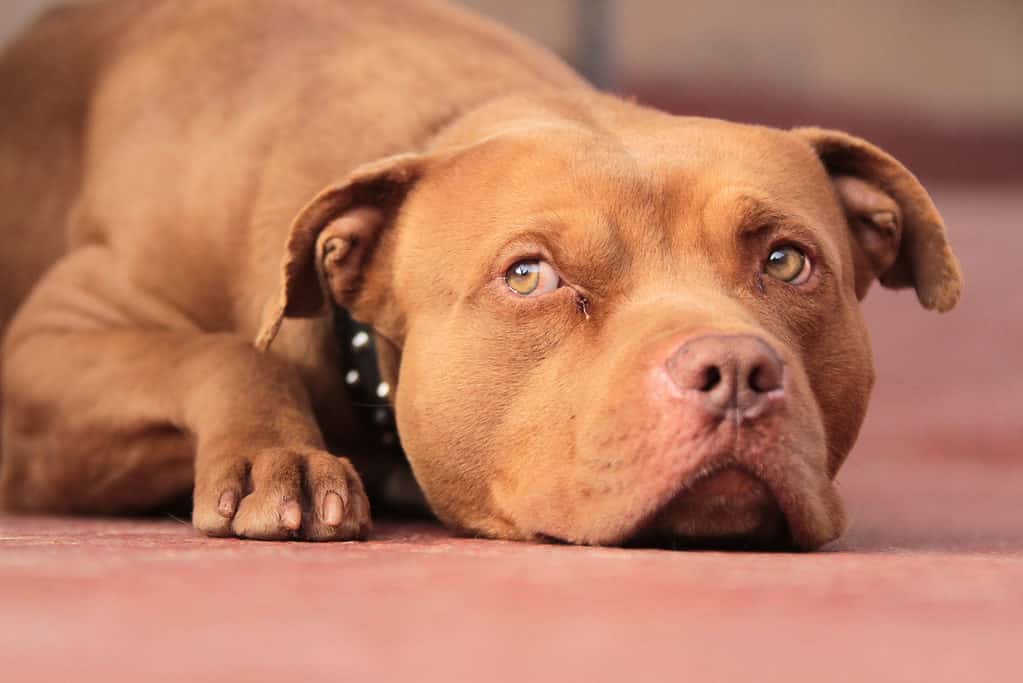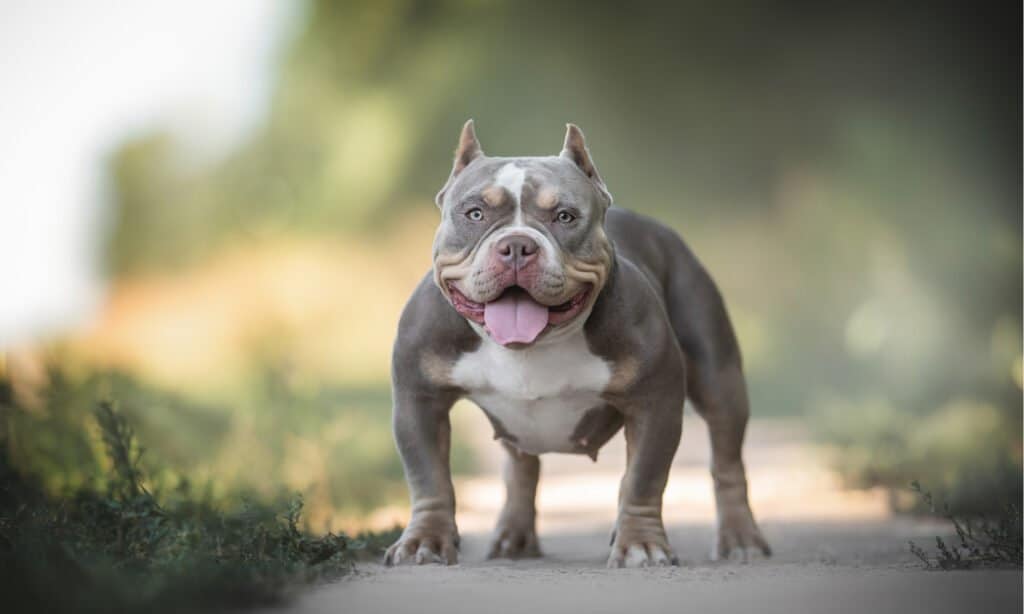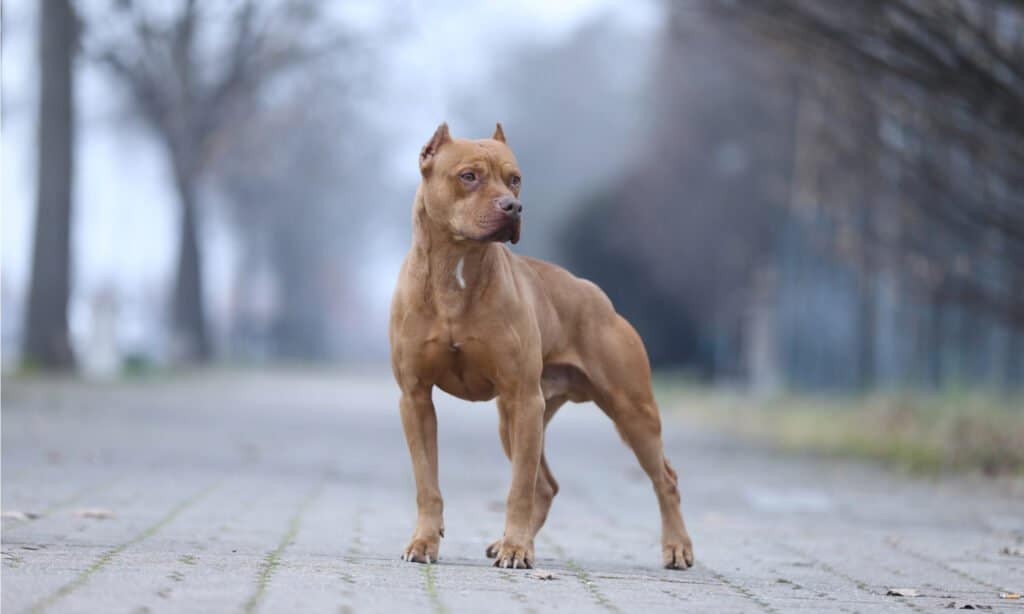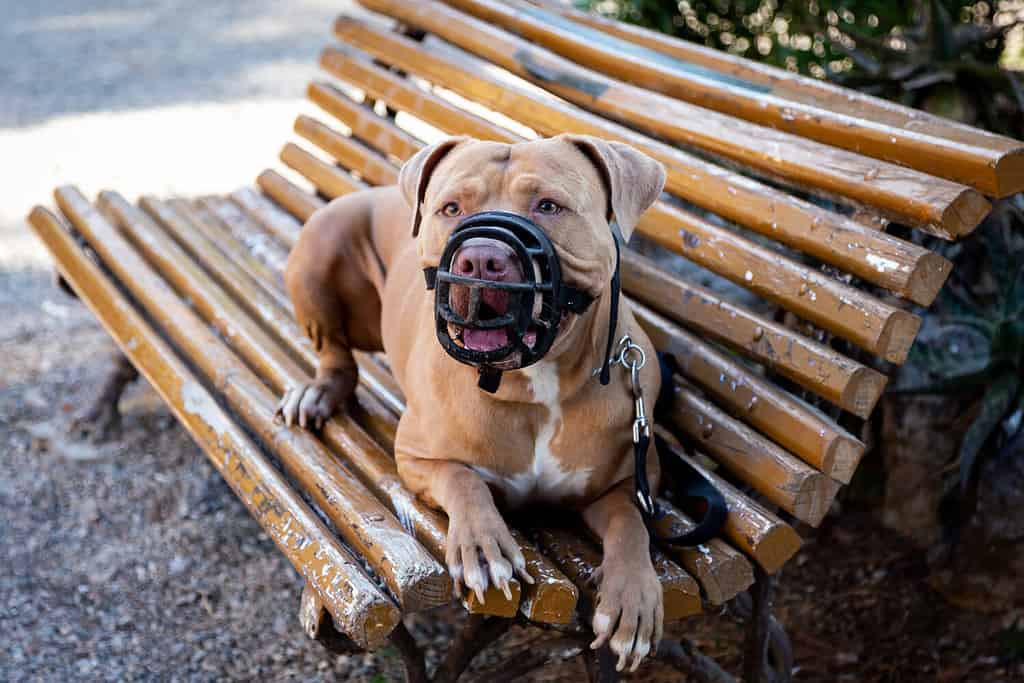Pit bulls and American bullies are dog breeds that have attracted significant attention and controversy. Although the pit bull and the American bully may share a resemblance in their looks, they have notable distinctions that set them apart.
In this article, we will look into these differences in detail, providing you with valuable insights and a comparison of the American bully versus the pit bull.
American Bully

Pocket pitbulls only reach about 16 inches tall.
The American bully breed’s distinctive attributes are a result of crossbreeding the American Staffordshire terrier and American pit bull terrier. In addition, a few other breeds, like the old English bulldog, American bulldog, and English bulldog, have contributed to the bully’s unique appearance and temperament.
In 2013, the United Kennel Club distinguished the American bully as a separate breed. There are four recognized types of American bullies: Pocket, Standard, Classic, and XL. However, in Europe, this breed is not specifically recognized, and some federal states require licensing for their ownership due to their classification as a “dangerous dog” breed.
Therefore, ownership of an American bully is subject to legal restrictions in certain regions.
Pit Bull

A group of dogs with ancestry from terriers and bulldogs is described as “pit bull” in the United States.
©David Cohen 156/Shutterstock.com
A group of dogs with ancestry from terriers and bulldogs is described as “pit bull” in the United States. This group includes different breeds, such as American Staffordshire terriers, Staffordshire bull terriers, American bullies, and American pit bull terriers. Sometimes, the contribution of American bulldogs is also present. Moreover, any dog of mixed breeding with physical characteristics resembling these breeds can also be categorized as a pit bull-type dog.
Pit bulls have a bad reputation as pets worldwide, largely due to their association with dog fighting. Their notoriety has been further increased by numerous high-profile attacks over the years, as well as their tendency to bite and hold on. However, it’s important to note that not all pit bulls are used for dog fighting, and the majority of them are friendly, loyal pets.
Local governments, typically at the county or municipal level, often enact breed-specific legislation. These laws can impose legal restrictions on pit bull ownership in certain regions.
Key Differences Between The American Bully And The Pit Bull
Let’s get down to the major differences between American bullies and pit bulls.

The American bully is a fascinating breed of dogs renowned for their medium-sized frames, compact yet muscular build, blocky heads, and heavy bone structure.
©Liudmila Bohush/Shutterstock.com
Size
The American bully is a fascinating breed of dogs renowned for their medium-sized frames, compact yet muscular build, blocky heads, and heavy bone structure. According to breed standards, male dogs should measure between 17 to 20 inches. Their female counterparts should range from 16 to 19 inches.
The weight range for the Classic American bully is typically between 60 to 120 pounds. While breeders have produced dogs outside of these variations in height, they’re not officially recognized as legitimate varieties by kennel clubs.
As mentioned earlier, the term “pit bull” does not point to one dog breed but rather serves as a collective descriptor for several unique dog breeds. In terms of height, pit bulls and American bullies exhibit similar averages. Male dogs stand between 18 and 21 inches tall, and females are between 17 and 20 inches. The weight differences, however, are quite noteworthy.
Pit bulls exhibit a wide range of weights, with some breeds reaching up to 80 to 90 pounds, while others maintain a healthy weight of merely 45 pounds. This is considerably lower than the typical weight of an American bully.
Look
The American bully’s coat is distinguished by its short length, closeness to the skin, firm texture, and glossy look. This breed exhibits various colors and patterns, all of which are considered acceptable. American bully’s head is moderately lengthy, showcasing a deep, wide skull, pronounced cheek muscles, and ears situated high on the head.
Pit bulls are quite distinguishable from the American bully. A key characteristic is their broad mouths, creating the illusion of a constant smile. They also have unmistakable blocky heads and ears that usually project outward.
The pit bull breed exhibits a vast array of colors, although it’s important to note that a coat consisting of 80% white may be deemed non-standard by some. Their builds can differ significantly based on the specific breed or mix – some may be short and sturdy, while others could be tall and slender. Nonetheless, their endearing grin and blocky head remain constant traits, irrespective of their physical form.
Breed Origins
The origins of the American bully and pit bull breeds are notably distinct. The American bully is a comparatively recent breed, emerging in the late 20th century. It was developed as a companion animal, intended to produce a breed well-suited for most households. Its unique size and build rapidly gained popularity, making it an appealing dog to observe and own.
On the other hand, the pit bull breed has a more extensive history, with its beginnings tracing back to the 1800s. It was initially bred for fighting purposes, and they were commonly found in various fighting events during that period.
In contrast to the American bully, the pit bull breed was trained for aggression and persistence, with the aim of attacking its adversary in the ring to secure victory. This training led to the breed’s recognition as one of the most effective for combative and aggressive uses.
Training
While both the American bully and the pit bull have similarities, their training needs and abilities differ. The American bully’s English bulldog lineage can make them more stubborn and independent. They require a more experienced dog owner who can understand their unique temperament and get the best out of them. This breed benefits from early and consistent training with positive reinforcement techniques, as they respond well to praise and rewards.
On the other hand, pit bulls are intelligent and eager to please, making them a good choice for dog owners. They are super trainable and thrive on positive reinforcement techniques, making them quick learners. While pit bulls may be easier to train, both breeds can benefit from the guidance of an experienced trainer to unlock their full potential.
Diet
The dietary requirements of the American bully and pit bull differ due to their varying sizes.
As a larger breed, the American bully needs more food to fulfill its daily nutritional needs. Ensuring your American bully receives the appropriate food quantity is crucial to avoid overfeeding, which could result in obesity and additional health problems.
On the other hand, the pit bull breed is typically smaller than the American bully and does not demand as much food to sustain its physique and energy levels. Nevertheless, it’s critical to supply your pit bull with a balanced diet for their well-being and happiness.
Lifespan And Health
Being a larger canine, the American bully is more vulnerable to health concerns associated with its size. Such issues may encompass joint complications, hip dysplasia, and obesity.
In contrast, the pit bull is a smaller dog and usually experiences fewer health problems.
Regarding lifespan, the American bully’s life expectancy ranges from 10 to 12 years. This is slightly less than the average lifespan of a pit bull, which, with appropriate care, can live between 12 and 16 years.
Pricing
In terms of cost, American bully puppies are generally more expensive than pit bulls. A pitbull puppy from a reputable breeder usually costs around $1,000. In comparison, an American bully puppy may cost around $1,200 or more. It’s important to mention that the large number of pit bulls in shelters throughout the United States can influence their market value.
The birth process for American bullies may also affect their pricing, as it can be more complex than other breeds depending on their size and build. Besides, if you’re considering partnering with a well-known or “canine celebrity” breeder, be prepared to pay a premium for their expertise. Buying from a reputable breeder who ensures proper care and health checks can be more expensive but may save you money in the long run by avoiding potential health and behavior issues. Additionally, adopting a dog from a shelter is often a more affordable option, and it provides a home to a dog in need.

A pit bull puppy from a reputable breeder usually costs around $1,000.
©Sophia Tr/Shutterstock.com
Pros And Cons Of American Bully And Pit Bull
Here are some pros and cons of owning an American bully or pit bull.
| American Bully Pros: | Pit Bull Pros: |
| Friendly | Loyal |
| Gentle | Affectionate |
| Good with children and other pets | Intelligent |
| Low-maintenance grooming needs | Good with children |
| Low-maintenance grooming needs |
| American Bully Cons: | Pit Bull Cons: |
| Can be aggressive towards other dogs if not properly socialized | High energy |
| Prone to health problems | Strong prey drive |
| Shorter lifespan than pit bulls | Can be aggressive towards other dogs if not properly socialized |
| Requires a lot of exercises |
Bonus: Why Do Some Countries Ban Pit Bulls?

Pit bulls are the most misunderstood, controversial dog breed in the world.
©entreguin/Shutterstock.com
Pit bulls were bred to fight chained bulls and later other dogs – resulting in a strong, muscular canine with a powerful bite force and aggressive tendencies. They are also known for biting and hanging on – refusing to release their bite even if they are lifted off the ground. They have a bad reputation despite support from such organizations as the American Society for the Prevention of Cruelty to Animals (ASPCA) and the American Veterinary Medical Association (AVMA).
Pro-ban supporters cite evidence that pit bulls contributed to 66% of all dog attack deaths in the U.S. between 2005 and 2019. Pit bull supporters argue that a dog’s upbringing and environment have a greater impact on behavior than breed-specific tendencies. As a result of the controversy – many countries have chosen to play it safe and ban the breed altogether. Countries that have banned pit bulls include:
- Argentina
- Belarus
- Bermuda
- Guyana
- Ireland
- Israel
- Italy
- Latvia
- Malaysia
- Malta
- New Zealand
- Norway
- Poland
- Puerto Rico
- Romania
- Russia
- Singapore
- Spain
- Switzerland
- Turkey
- Ukraine
- United Arab Emirates
- United Kingdom
- Venezuela
Ready to discover the top 10 cutest dog breeds in the entire world?
How about the fastest dogs, the largest dogs and those that are -- quite frankly -- just the kindest dogs on the planet? Each day, AZ Animals sends out lists just like this to our thousands of email subscribers. And the best part? It's FREE. Join today by entering your email below.
Thank you for reading! Have some feedback for us? Contact the AZ Animals editorial team.








